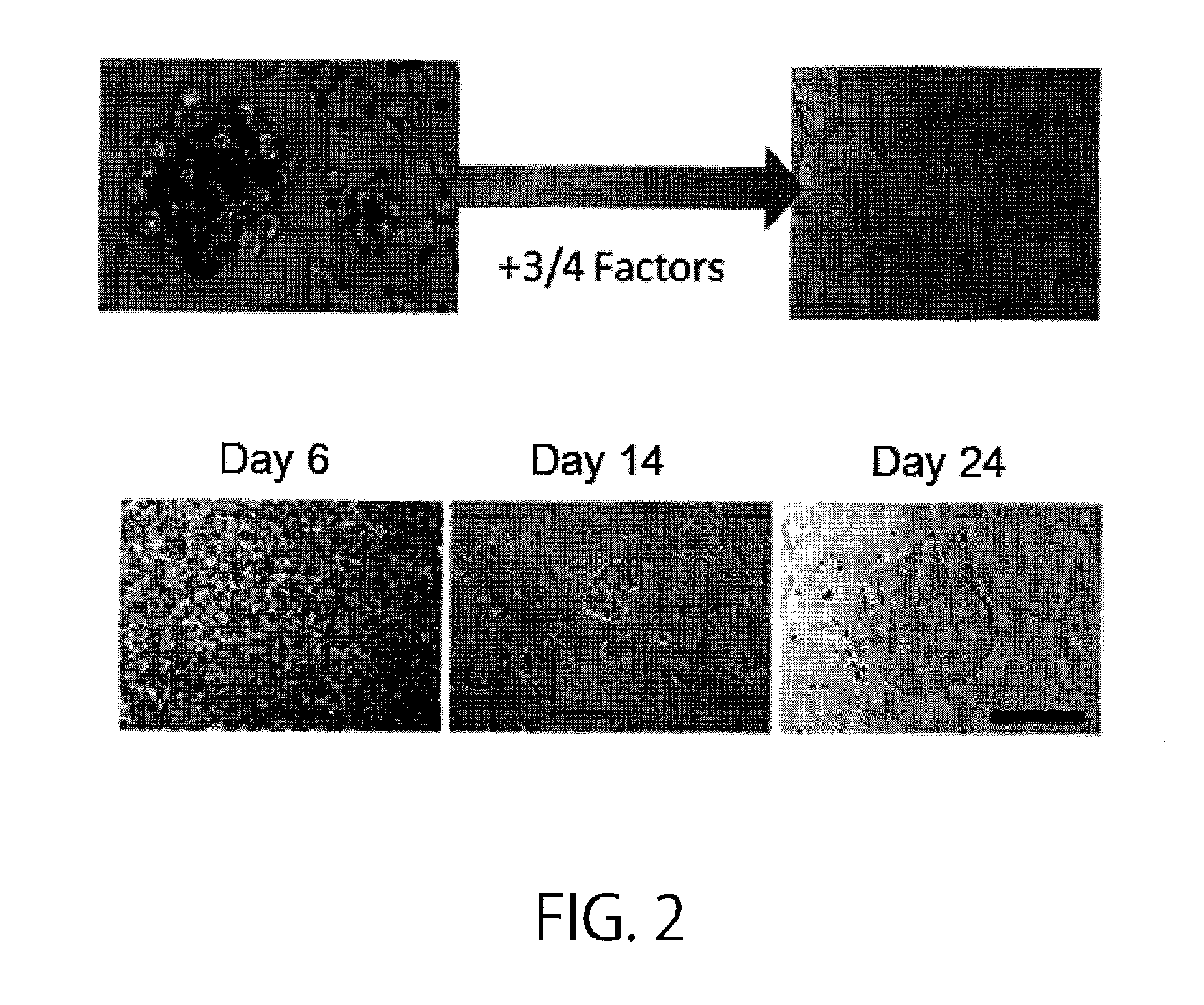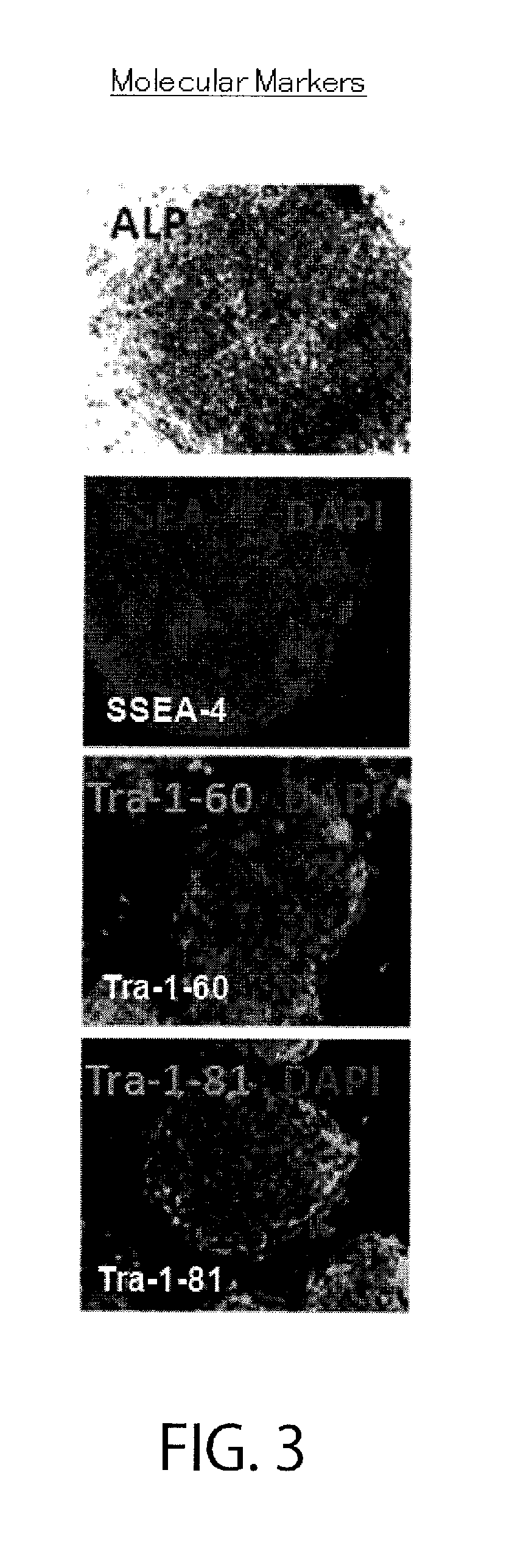Method for reconstructing immune function using pluripotent stem cells
a technology of pluripotent stem cells and immune function, which is applied in the direction of biocide, genetically modified cells, antibody medical ingredients, etc., can solve the problems of reduced ex vivo self-renewal capacity, difficult to take good advantage of their specificity, and no effective treatment methods have been established at present, so as to achieve the effect of fewer problems and efficient production of human t lymphocytes
- Summary
- Abstract
- Description
- Claims
- Application Information
AI Technical Summary
Benefits of technology
Problems solved by technology
Method used
Image
Examples
example a
[0170]The present invention will be described more specifically below based on Examples, but is not limited to the below-mentioned Examples. Examples A1 to A6 used the below-mentioned materials and were carried out according to the below-mentioned methods.
[0171]Flow cytometry analysis was carried out using MoFlo (manufactured by Dako Cytomation), FACSAria® (manufactured by BD Bioscience), or FACSCanto II® (manufactured by BD Bioscience). Analysis of data obtained was performed using a FlowJo software (manufactured by Treestar). The antibodies used in the flow cytometry analysis were as follows: Anti-human CD3-APC (manufactured by BD Bioscience), anti-human CD4-FITC (manufactured by BD Bioscience), anti-human CD8-PerCP / Cy5.5 (manufactured by BD Bioscience), anti-human CD56-PE (manufactured by BD Bioscience), anti-human CD45RA-Pacific Blue (manufactured by Caltag Laboratories), anti-human CD62L-PE-Cy7 (manufactured by Biolegend), anti-human CD45-Alexa 405 (manufactured by Molecular Pr...
example a1
Establishment of iPS Cells from Human Peripheral Blood T Cells
[0203]First, T cells in human peripheral blood were used to establish iPS cells as shown in FIG. 1. In brief, PBMCs or CD3 positive cells were isolated from peripheral blood obtained from healthy individuals (of various ages (from 24 to 56 years old) and both sexes), and stimulated with CD3 / CD28 ClinExVivo beads. Then, the cells were cultured for 2 days in RPMI1640+10% FBS+PSG (penicillin, streptomycin, and L-glutamine) containing 20 ng / mL hIL-2, and subjected to gene introduction using the VSV-G pseutotype retrovirus vectors pMX OCT4, pMX SOX2, pMX KLF4, and pMX c-MYCm, or alternatively pMX OCT4, pMX SOX2, and pMX KLF4. Operations for gene introduction were carried out for two successive days. Then on six days after the day of isolation, 1×105 cells were seeded on a layer of irradiated MEFs (mouse embryonic fibroblasts) grown in a 6-cm dish, and half the volume of the culture medium each time was replaced every day with ...
example a2
[0207]In order to ascertain that the established iPS cell clones were derived from T cells, the rearrangement in their TCR gene was examined. In the TCR gene, three groups, TCRδ, TCRγ, and TCRβ, begin their rearrangement at early stages (almost in this order). A rearrangement of the TCRγ gene was confirmed in 2 of 4 clones derived from the “4 Factors” and in 6 of 9 clones derived from the “3 Factors” (see FIG. 9, electrophoresis). Analysis of the rearrangement in the TCRβ and TCRα genes in these clones found that all these clones had respective in-frame rearrangements of the TCRβ and TCRα genes (see Table 5, in-frame gene rearrangement in the TCRα chain region, and Table 6, in-frame gene rearrangement in the TCRβ chain region). In all of their respective rearrangements, there were not observed combinations of the NKT-cell type in which TRAV24 and TRBV11 were used specifically, and thus it was ascertained that the established iPS cell clones were ones derived from peripheral blood T ...
PUM
| Property | Measurement | Unit |
|---|---|---|
| concentrations | aaaaa | aaaaa |
| concentrations | aaaaa | aaaaa |
| concentrations | aaaaa | aaaaa |
Abstract
Description
Claims
Application Information
 Login to View More
Login to View More - R&D
- Intellectual Property
- Life Sciences
- Materials
- Tech Scout
- Unparalleled Data Quality
- Higher Quality Content
- 60% Fewer Hallucinations
Browse by: Latest US Patents, China's latest patents, Technical Efficacy Thesaurus, Application Domain, Technology Topic, Popular Technical Reports.
© 2025 PatSnap. All rights reserved.Legal|Privacy policy|Modern Slavery Act Transparency Statement|Sitemap|About US| Contact US: help@patsnap.com



